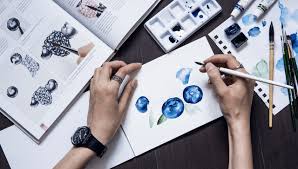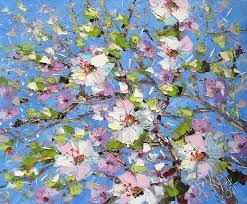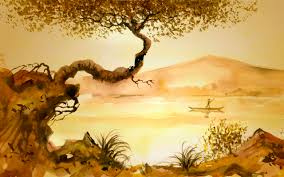PRINT. CLASSIFICATION AND VARIETIES (part 2)
 Lavis (from Fr. lavis – wash) – a kind of aquatint. Known since the 1780s. The drawing is applied by needle etching. The tonality is obtained by etching with acid, which is applied to the board with a brush. The boundaries of the tone spot are sharply defined. The print of Lavis resembles a work executed in watercolor. Lavis is very close to aquatint in terms of its external visual characteristics, but differs from it in watercolors of a tone spot, softness and fuzziness of outlines. Like aquatint, Lavis is used in combination with other etchings, for example, with a dry needle. The technique allows you to get no more than 30 quality prints from one board.
Lavis (from Fr. lavis – wash) – a kind of aquatint. Known since the 1780s. The drawing is applied by needle etching. The tonality is obtained by etching with acid, which is applied to the board with a brush. The boundaries of the tone spot are sharply defined. The print of Lavis resembles a work executed in watercolor. Lavis is very close to aquatint in terms of its external visual characteristics, but differs from it in watercolors of a tone spot, softness and fuzziness of outlines. Like aquatint, Lavis is used in combination with other etchings, for example, with a dry needle. The technique allows you to get no more than 30 quality prints from one board.
Zuev Alexey. Lada. Molodetsky Kurgan – Reservazh Reservazh (from French réservage) is a type of etching. The reserve first appeared in France in the second half of the 19th century.
Ink, gouache or ink with sugar added, a pen or brush is applied to the smooth surface of the metal. The plate is then coated with acid resistant primer and lowered into water. Swollen, ink lifts the soil particles lying above them, which are easily removed, exposing the metal. Then the printing form is dipped in nitric acid and an etching machine imprints on paper. It turns out an engraving resembling a sketch with a pen or drawing with a brush.
Gavriil Ivanovich Skorodumov. Portrait of Catherine II from the originals of F.S. Rokotov – Pencil manner, dashed line, Pencil manner – a kind of dashed manner of in-depth engraving on metal, imitating drawing with a pencil, charcoal, sanguine or pastel. It is a combined technique – half etching, half cutting. It was created exclusively for the reproduction of drawings and as an independent manner was not widely used. It was born in France in the middle of the XVIII century.
Engraved on etching varnish with roulettes of various kinds (pens with gear wheels) and mituar (pestle with implanted teeth). After acid etching, the lines are reinforced with a stylus, a needle and tape measures directly on the printing plate. Typically, pencil drawings reproduce drawings in pencil, pastel, sanguine, charcoal. Sometimes in this technique, grafts are made mechanically without etching and soil. Pencil style was often used in combination with dotted technique.
Wiiralt Edward. Berber girl with a camel – Soft varnish. 1940. Soft varnish is a type of etching technique. An acid-resistant layer of soft varnish is applied to the printing plate, then a sheet of thin paper is carefully applied. After that, a drawing is applied on paper with a pencil. A pencil pushes through the paper, and it in turn sticks to a soft varnish. When the paper is removed, it tears off the varnish from the printing plate and exposes the metal. Then the printing form is dipped in nitric acid and an etching machine imprints on paper.
Linocut Linocut – engraving on linoleum. Appeared at the turn of the XIX-XX centuries with the invention of linoleum. For linocut, specially prepared linoleum is used, the image is cut out with cutters of different sizes. Then it is covered with a roller with special paint and a print is made on paper.
Laconicism of the artistic language; sharp contrasts of black and white; juicy and picturesque touch, obtained due to the softness of the material; the ability to work fast; use a large sheet size; color printing and high circulation attracted many masters of printed graphics. Due to the comparative simplicity of execution and large circulation, linocut became available to a wide range of viewers.
Sergey Dudko. Tien Shan, Pamir 2000 – Engraving on cardboard Engraving on cardboard – cardboard of various densities is used as the material for the printing form. Strokes on the cardboard are cut with a needle or a knife, tone planes are achieved by loosening the surface of the cardboard or by application. The artistic possibilities of cardboard engraving are very limited, so it is not widely used among professional artists.
Lithography, autolithography Lithography, autolithography (from the Greek. Lithos – stone and grapho – I write, draw) – a printing method in which ink is transferred from a lithographic stone to paper under pressure under pressure. The lithograph is mistakenly considered to be an engraving; it was invented in 1798 by Aloisius Zenefelder in the vicinity of Munich.
The process of creating lithography is as follows: an image is drawn on a lithographic stone (a piece of dense limestone, which is ground to a smooth state), then the surface of the stone is etched with a mixture containing nitric acid, which acts on an uncoated surface. A paint roller is applied to the moistened stone with a roller, adhering only to the non-etched parts of the stone, then, using a lithographic machine, a print is made on paper.




